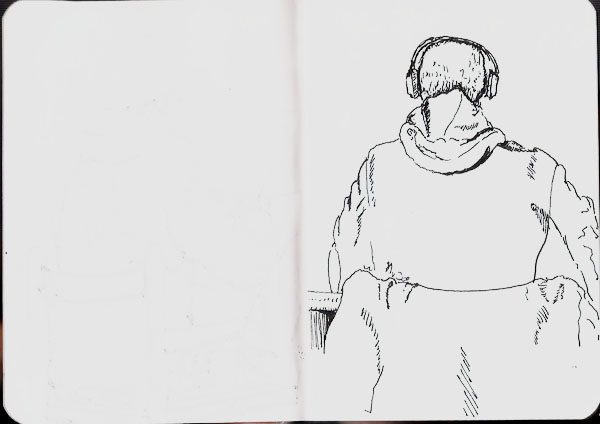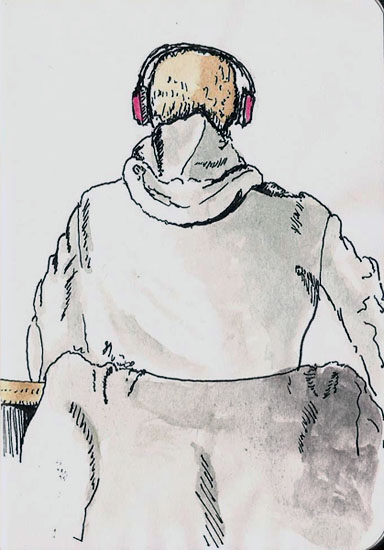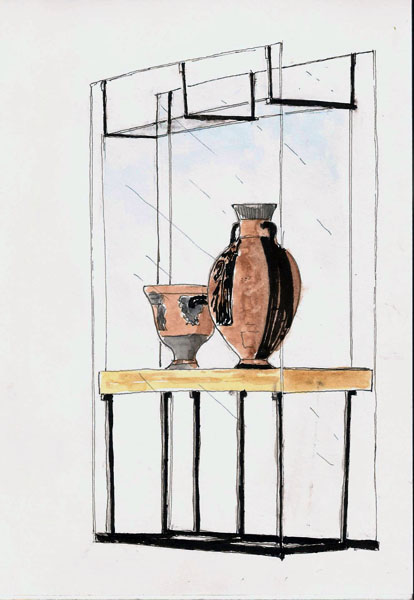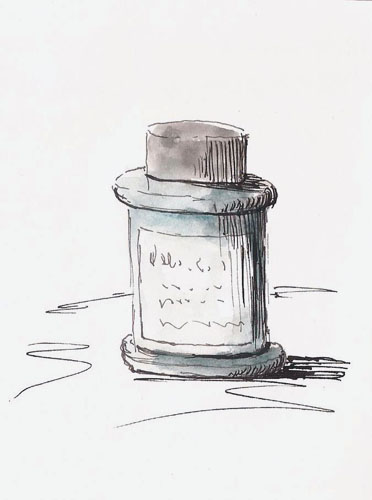One of the highlights of this otherwise miserable winter was taking Marc Taro Holme’s People in Motion class. During the class Marc suggests that you get a small, cheap notebook and sketch in it constantly. He recommends the Moleskine Cahier (same paper as the Moleskine notebooks but without the hard cover).
I think the idea of a small, cheap notebook that facilitates sketching everywhere and all the time is a great one. On recommendation from my mentor and buddy, Yvan Breton, I’ve been doing this for a couple years and it’s done more for my ability to draw than anything else I do.
What I hadn’t tried was the Moleskine Cahier so I bought some. They come in a 3-pack for about $12 around here. I was very disappointed because of bleed-through and lots of ghosting when I used my fountain pens. I complained about this here, and included a bunch of sketches to illustrate the problems.
But what I really did like about these little books was how small they were. My typical small book has a hard cover and 96 cheap-paper pages. These books are 5.5 x 3.5 x 0.5″ while the Cahiers are only 48 pages with a thick paper cover and are thus about 1/8″ thick. Very portable, very light in the hand. If only….
There are alternatives and I’ve been trying them. Tina Koyama motivated me to try Baron Fig‘s notebooks, and I think I might be falling in love with their little Apprentice notebooks.
While the typical small notebook is 3.5″ x 5.5″, the Baron Fig is 3.5″ x 5″. When I received them this threw me off a bit as I was more used to the other size but now that I’ve used it a bit I find that I actually prefer it. It fits my hand better and certainly fits in a pocket more easily. Size does matter.
The books are 48-pages of white (an improvement over Moleskine) paper and cardstock cover. They are stitch-bound rather than stapled like most of their competition. It’s a nice touch and the stitching is perfect.
While they can be had with lines, grid or blank paper, I bought a pack of their standard gray notebooks (3 per pack) and a pack of their “limited edition” Time Travel series. They cost only $10 per pack so, $3.33 per notebook. Not bad even if you do use a lot of them.
All this is great but the proof is in how they handle ink. For me that means fountain pen ink. Typically I use fine nib pens in my small notebooks because of the small format and a side benefit is that it places lower demands on the paper when it comes to bleed-through and ghosting.
But what happens if you do use a lot of ink on Baron Fig paper? The results are better than I thought. I decided to try Tina Koyama’s favorite pen, the Sailor Fude pen. This pen can lay down a lot of ink or a little ink depending on the nib angle. Here’s the result of this experiment.
Of course the “proof in the puddin” is to look at the back of this sketch. Here it is (on the left):
As you can see, there is some ghosting but not much in the way of bleed-through. We’re not talking about doing drawings that you’re going to frame so, to me, this is acceptable. The sketch on the right was done with a Namiki Falcon SEF. This is my typical nib size for these and the ghosting on the back of this sketch is negligible.
But what if you wanted to use the Sailor pen and also wanted to draw on that ghosted page? Could you do it? Sure, the ghosting wouldn’t distract from your sketching. It might, however, not look as nice as you’d like when you scanned it to send it to your favorite social media group. But, with the magic of Photoshop (or some other graphics program), you can easily remove this ghosting so that it looks like this:
These results are the same as I’ve gotten from the paper in my cheap hardcover books so I’m thrilled and the paper in the Baron Fig as it looks better and feels better.
My cheap book sketches rarely see any color, simply because I’m generating lots of sketches as I wander through my day and so there’s no time for color. But, for this post I decided to add a bit of color to see how that worked. I kept the washes light and didn’t expect to move them around much. I was surprised at how well it worked.
This is definitely not watercolor paper but I was happy with the results. This does increase the ghosting a little bit but surprisingly little, as long as you wait for the paper to dry. This definitely opens the door for me to use my gray and brown waterbrushes to shade drawings on the fly. If you’re looking for a small, very portable, sketchbook solution, the Baron Fig Apprentice might be what you need.










